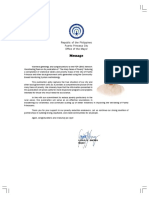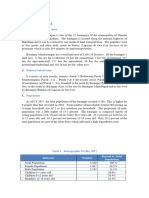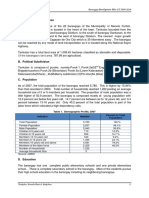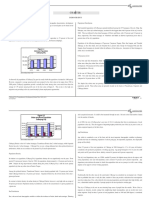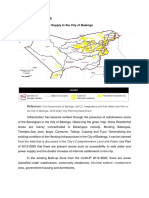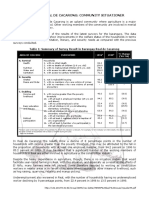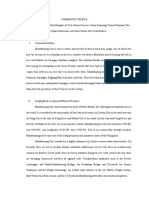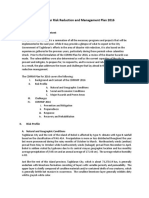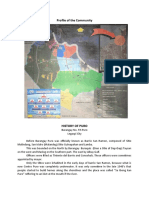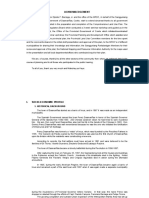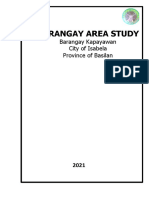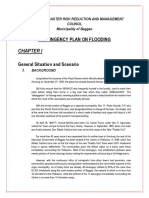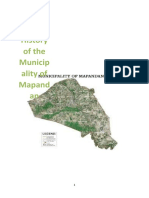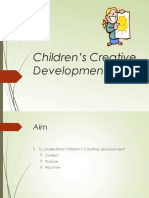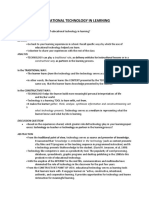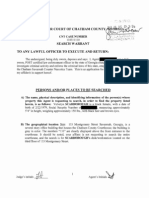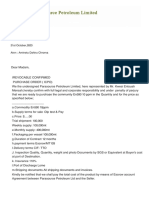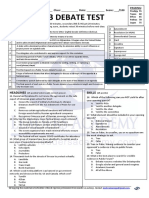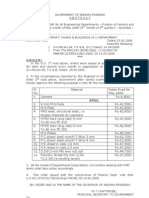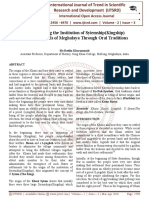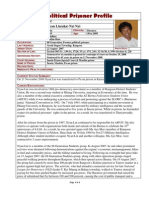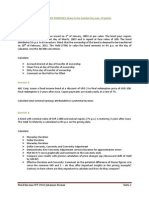Message: Republic of The Philippines Province of KALINGA City of Tabuk
Uploaded by
Marie Joy GarmingMessage: Republic of The Philippines Province of KALINGA City of Tabuk
Uploaded by
Marie Joy GarmingRepublic of the Philippines
Province of KALINGA
CITY OF TABUK
Message
My Warmest Greetings!
In our pursuit to combat poverty, the City has adopted the implementation
of the Community Based Monitoring System (CBMS). Initially, in 2011, we
Mayor Montilla’s Photo
conducted the first phase of the Community Based Monitoring System Sur vey
through the utilization of the paper-based survey instrument and in 2015, we
adopted the CBMS Accelerated Poverty Profiling (APP) Tracking using tablets to
upgrade and enhance the profiling and database.
This survey has been an effective tool in the planning activities of our city.
Data generated were used to build the capacities of our LGU and communities,
facilitate resource allocation and enrich existing databases among others. It is
for these reasons that we unhesitatingly supported this program.
On behalf of the City of Tabuk, I and the whole Local Government Unit extend our deep appreciation and
gratitude to the CBMS Network Of fice and the Department of Interior and Local Government for your unending
support and assistance to our City with regards to this endeavor.
Thank you! Matatago-tago tako losan!
FERDINAND B. TUBBAN
City Mayor
The Many Faces of Poverty (Volume 7)
73
The Many Faces of Poverty in Tabuk
POPULATION
City of Tabuk had a total population of 99,900 covering 20,812 households
Tabuk City is a component city in the province of Kalinga. The CBMS census conducted in 2015 covered all 42
barangays in the city with a total population of 99,900 in 20,812 households with a response rate of 76.9 percent.
The total number of males is 51,776 which accounts for 51.8 percent, while the total number of females is
48,124 or 48.2 percent of the population. Barangay Bulanao has the largest population of 14,718 or 14.7 percent
of the population. This was followed by Barangay Agbannawag with 4,713 individuals or 4.7 percent of the population
of the city during the census period.
HEALTH AND NUTRITION
Two in every one thousand children under
five years old died
About 0.2 percent of children zero to four
years old died during the period. This
corresponds to a total of 25 child deaths
among children under five years old.
Further, estimates of child deaths among
girls and boys were at 0.3 and 0.2 percent,
respectively. This translates to 15 boys and
10 girls between under five years old who
died. The highest proportion of child death
was repor ted in Barangay Bantay and
Masablang where 2.1 percent of children
under five years old died. This was followed by Barangay Bagumbayan at 1.6 percent with one record of child death.
No cases of child deaths were reported in 25 out of 42 barangays in Tabuk City.
No case of maternal death was reported in the city
Results of the CBMS census in the city revealed that no pregnant woman aged 15-49 died due to pregnancy-related
causes during the reference period.
The Many Faces of Poverty (Volume 7)
74
Around 3 in every 100 children zero to five years
old were malnourished
About 3.3 percent or 444 children zero to five
years old were classified as moderately or
severely underweight in the city. In particular,
213 boys and 231 girls zero to five years old
we re con side re d ma ln ou rish ed . It
corresponds to 3 malnourished children for
every 100 children five years old and below.
Malnutrition prevalence among boys at 3.0
percent was lower than girls at 3.6 percent.
Barangay Malin-awa recorded the highest
propor tion at 10.5 percent, followed by
Guilayon at 9.6 percent. In terms of magnitude, Bulanao recorded the highest number of malnourished children
with 52 cases. Also, 2 out of the 42 barangays in the city recorded no cases of malnourished children zero to five
years old.
HOUSING
About 1.7 percent of households were living in makeshift housing while 2.5 percent were informal settlers
The 2015 CBMS data showed that about 2 in every 100 households in the city were living in makeshift housing.
Barangay Lucog had the highest propor tion and magnitude of households living in makeshift housing with 22.6
percent or 63 households. This was followed by Malalao with 8.8 percent or 11 households. Barangay Dilag
ranked fifth in terms of proportion, but second in terms of magnitude with 5.3 percent or 41 households.
In terms of tenure status, around 3 in every 100 households in the city were considered as informal settlers.
Barangay Dilag had the most number and highest proportion of informal settlers at 14.2 percent or 110 households.
Dagupan Centro was second in terms of proportion with 8.1 percent of the households were informal settlers,
followed by Balong with7.6 percent. Also, 6 of the 42 barangays in the city recorded no cases of informal settlers.
The Many Faces of Poverty (Volume 7)
75
WATER AND SANITATION
About 6.2 percent of the households did not have access to safe water supply and about 20 percent did not have
access sanitary toilet facilities
Based on the results of the CBMS census, about 6.2 percent or at least 6 in every 100 households in the city had
no access to safe water supply. Barangay Malalao had the worst condition in terms of water accessibility as more
than half or 60.8 percent or 76 reported cases of households were reported to have no access to safe water
supply during the reference period. This was followed by Bado Dangwa with 32.4 percent or 125 reported cases.
In terms of magnitude, Bulanao reported the highest number of households with no access to safe water supply at
138. Disaggregated data further revealed that no barangay in the city was "waterless". In fact, all households in 9
barangays in Tabuk City reported to have access to safe water supply.
1
“Waterless” barangays refer to villages with less than 50 percent safe water supply coverage, as de fined by the SALINTUBIG
Program of the Depar tment of Health (DOH).
The Many Faces of Poverty (Volume 7)
76
Meanwhile, about 20 percent or 4,158 households do not have access to sanitary toilet facilities. This means that
20 in every 100 households in the city were sanitation poor. Barangay Guilayon reported that highest proportion of
households with no access to sanitary toilet facilities at 85.3 percent or 163 cases. This was followed by Malin-
awa with 78.9 percent. Lacnog came in third with 65.7 percent of households do not have access to sanitary toilet
facilities, however, it ranked first in terms of magnitude with 536 reported cases.
BASIC EDUCATION
Around 3 in every 100 children 6 to
15 years old were not attending school
The propor tion of out-of-school
children among 6-15 years old was
2.6 percent. This means that about
3 in every 100 children 6-15 years
old were not attending school
regardless of education level. Further,
results revealed that out-of-school
children among boys (3.6%) were
higher compared to girls (1.6%).
Barangay Guilayon, with 6.7 percent,
had the highest proportion of children
aged 6-15 years who were not
attending school. It was closely
followed by New Tanglag with 6.2 percent and Nambaran with 5.3 percent. In terms of magnitude, Bulanao ranked
first with a total of 45 children 6-15 years old who were not in school during the reference period.
INCOME AND LIVELIHOOD
About 37 in every 100 households were living below the poverty threshold
More than one third or 7,771 households in the city were considered income poor. This translates to around 37 in
every 100 households having no sufficient income to satisfy their basic food and non-food needs. Guilayon recorded
the highest proportion of income poverty with 83.2 percent of households living below the poverty threshold. This
was followed by Nambucayan with 79.4 percent and Magnao with 77.2 percent. It can also be noted that 11 of the
42 barangays in the city reported an income poverty rate of at least 50 percent. This means that at least half of the
households in these barangays suffered deprivation in terms of income.
The Many Faces of Poverty (Volume 7)
77
About 23 in every 100 households had no sufficient income to satisfy their food needs
The CBMS data also showed that 23.7 percent or 4,927 households in the city were living below the food threshold.
This means that about 24 in ever y 100 households had no sufficient income to satisfy their basic food needs
during the reference period. Subsistence incidence was most prevalent in Barangay Guilayon where 74.9 percent
or 143 households were food poor. Nambucayan and Gobgob also recorded high incidence of subsistence where
67.3 percent and 63.8 percent of the households, respectively, were living below the food threshold. In terms of
magnitude, Barangay Bulanao had the most number of food poor households with 308 recorded cases.
Less than one percent of households experienced hunger due to food shortage
Only 0.2 percent or 46 households suffered from hunger during the three-month period before the censu,s which
represents 2 in every 1000 households. Across all the barangays, Guilayon had the highest proportion and magnitude
of households that suffered from hunger at 16.8 percent or 32 reported cases. Meanwhile, 34 of the 42 barangays
in the city had no recorded cases of hunger due to food shortage.
Unemployment rate in the city was recorded at 7.4 percent
Of the 36,335 members of the labor force aged 15 and above, about 7.4 percent or 2,678 individuals reported to
be unemployed. The results of the census further showed that the unemployment rate was higher among females
at 10.7 percent than among males at 5.7 percent. Across all barangays, Lacnog recorded the highest unemployment
rate at 23.4 percent, followed by Agbannawag with 13.9 percent. Meanwhile, Bulanao had the highest number of
unemployed members with 373 individuals followed by Lacnog with 305 unemployed members of the labor force.
PEACE AND ORDER
About 0.1 percent of the population were victims of crime
A total of 109 individuals or about 0.1 percent reported to be victims of crime. Among all the barangays, Balawag
recorded the highest proportion of crime victims with 0.6 percent or 9 cases. This was followed by Bagumbayan
with 0.5 percent or 3 cases. Barangay Bulanao came in fourth in terms of proportion (0.3%) but first in terms of
numbers where 39 individuals were reported to be victims of crime. It is also wor th noting that 14 of the 42
barangays in the city had no reported victims of crime during the reference period.
The Many Faces of Poverty (Volume 7)
78
CBMS COMPOSITE INDICATOR2
Households in Tabuk City suffered from one deprivation on the average
The city recorded a CBMS composite index (CCI) of 1.1. This means that some households in the city suffered from
around one deprivation, on the average. Barangay Guilayon, for instance, had a composite index of 2.9. This
means that about 3 deprivations were experienced by households in the said barangay on the average. Magnao,
Gobgob, and Bado Dangwa also have recorded a CCI of at least 2.
DIMENSIONS OF POVERTY IN TABUK CITY
DIMENSIONS OF POVERTY3
Of the households, 17.1 percent were poor in at least two dimensions
Based on the CBMS data, 48 percent or 9,980 households in Tabuk City experienced at least one deprivation. This
means that 52 percent of the households in the city were non-poor. Of the households, 17.1 percent or 3,564
households experienced multiple deprivations. In particular, 30.8 percent of households in Tabuk City were poor in
one dimension while 13 percent were poor in two dimensions at the same time. Further, 4.1 percent were poor in
at least three dimensions, simultaneously.
2
The deprivations are based on the 13+1 indicators: (1) children 0-4 years old who died; 2) women who died due to pregnancy-
related causes; (3) malnourished children 0-5 years old; (4) households living in makeshift housing ; 5) households who are informal
settlers; (6) households without access to safe water supply; (7) households without access to sanitar y toilet facilities; (8) children
6-16 years old not in school; (9) households with income below the pover ty threshold; (10) households with income below the food
threshold; (11) households that experienced food shor tage; (12) unemployment; and (13) victims of cr ime. A higher index would
mean more deprivation and hence, worse condition for the households.
3
The dimensions of pover ty being considered are the following: health, nutrition, tenure, housing, water, sanitation, education,
income, job, and security.
The Many Faces of Poverty (Volume 7)
79
The Many Faces of Poverty (Volume 7)
80
The Many Faces of Poverty
in the City of Tabuk
CBMS Core Indicators, City of Tabuk, 2015
Households Population
Magnitude Proportion Magnitude Proportion
INDICATOR
DEMOGRAPHY
Population 20,812 99,900
Average household size 5
Children under 1 year old 1,784
Children under 5 years old 11,041
Children 0-5 years old 13,507
Children 6-11 years old 14,027
Members 12-15 years old 8,782
Members 6-15 years old 22,809
Members 10 years old and above 77,124
Members of the labor force 36,335
HEALTH AND NUTRITION
Children under 5 years old who died 25 0.2
Women who died due to pregnancy related-causes 0 0
Malnourished children 0-5 years old 444 3.3
HOUSING
Households living in makeshift housing 351 1.7
Households who are informal settlers 518 2.5
WATER AND SANITATION
Households without access to safe water supply 1,287 6.2
Households without access to sanitary toilet facilities 4,158 20.0
BASIC EDUCATION
Children 6-11 years old not attending elementary school 1,208 8.6
Children 12-15 years old not attending high school 2,623 29.9
Children 6-15 years old not attending school 602 2.6
INCOME AND LIVELIHOOD
Households with income below pover ty threshold 7,771 37.3
Households with income below food threshold 4,927 23.7
Households who experienced hunger due to food shor tage 46 0.2
Unemployment rate (15 years old and above) 2,678 7.4
PEACE AND ORDER
Victims of crime 109 0.1
CBMS Composite Indicator, City of Tabuk, 2015
Average
CBMS Composite Indicator 1.1
The Many Faces of Poverty (Volume 7)
81
Total Number of Households and Population, by Barangay, City of Tabuk, 2015
Barangay Total households Total population Total male Total female
population population
Agbannawag 954 4,713 2,456 2,257
Amlao 159 871 473 398
Appas 585 2,683 1,446 1,237
Bado Dangwa 386 2,030 1,078 952
Bagumbayan 118 630 330 300
Balawag 283 1,583 829 754
Balong 462 2,070 1,086 984
Bantay 221 1,023 554 469
Bulanao 2,866 14,718 7,426 7,292
Bulanao Nor te 1,035 4,671 2,344 2,327
Bulo 785 4,065 2,073 1,992
Cabaritan 242 1,030 548 482
Cabaruan 430 1,790 941 849
Calaccad 434 2,065 1,075 990
Calanan 318 1,531 797 734
Casigayan 627 2,759 1,412 1,347
Cudal 640 3,108 1,582 1,526
Dagupan Centro 569 2,439 1,224 1,215
Dagupan West 902 3,840 1,974 1,866
Dilag 774 3,569 1,831 1,738
Dupag 232 1,128 579 549
Gobgob 417 1,993 1,083 910
Guilayon 191 955 506 449
Ipil 608 3,040 1,631 1,409
Lacnog 816 4,467 2,349 2,118
Lanna 231 935 507 428
Laya East 377 1,777 903 874
Laya West 471 2,295 1,205 1,090
Lucog 279 1,462 779 683
Magnao 224 1,126 597 529
Magsaysay 917 3,875 1,990 1,885
Malalao 125 561 307 254
Malin-awa 332 2,037 1,047 990
Masablang 228 973 541 432
Nambaran 764 3,309 1,688 1,621
Nambucayan 223 1,079 584 495
Naneng 158 856 463 393
New Tanglag 268 1,426 735 691
San Juan 463 2,275 1,146 1,129
San Julian 265 1,169 616 553
Suyang 108 460 265 195
Tuga 326 1,514 776 738
The Many Faces of Poverty (Volume 7)
82
CBMS Poverty Maps: City of Tabuk
Map 1. Proportion of Children under 5 Years Old who Died, by Barangay, 2015
CABARITAN
DAGUPAN CENTRO
CASIGAYAN
Bottom 11 Barangays
Barangay Magnitude Proportion
Bantay 2 2.1
Masablang 2 2.1
Bagumbayan 1 1.6
Suyang 1 1.5
Dagupan West 3 0.8
Laya West 2 0.8
Calanan 1 0.6
Laya East 1 0.6
Balawag 1 0.6
Cabaruan 1 0.5
Magsaysay 2 0.5
The Many Faces of Poverty (Volume 7)
83
CBMS Poverty Maps: City of Tabuk
Map 2. Proportion of Women who Died Due to Pregnancy-Related Causes,
by Barangay, 2015
CABARITAN
The Many Faces of Poverty (Volume 7)
84
CBMS Poverty Maps: City of Tabuk
Map 3. Proportion of Children 0-5 Years Old who are Malnourished,
by Barangay, 2015
CABARITAN
Bottom 10 Barangays
Barangay Magnitude Proportion
Malin-awa 34 10.5
Guilayon 14 9.6
Balong 25 7.7
Cudal 32 7.2
Balawag 14 6.7
Bado Dangwa 19 6.6
Laya West 19 6.1
Naneng 7 5.5
Ipil 25 5.4
Bagumbayan 4 4.9
The Many Faces of Poverty (Volume 7)
85
Table 1. Health and Nutrition Indicators, by Barangay, City of Tabuk, 2015
Barangay Number of Children under 5 Number of Women deaths due Number of Malnourished
children years old children to pregnancy-related children children
(under who died (under causes (0-5 years old) (0-5 years old)
5 years old) 1 year old)
Magnitude Proportion Magnitude Proportion Magnitude Proportion
Agbannawag 548 1 0.2 83 0 0 677 21 3.1
Amlao 104 0 0 23 0 0 122 2 1.6
Appas 297 1 0.3 31 0 0 359 5 1.4
Bado Dangwa 244 1 0.4 43 0 0 286 19 6.6
Bagumbayan 63 1 1.6 14 0 0 81 4 4.9
Balawag 166 1 0.6 25 0 0 208 14 6.7
Balong 261 0 0 41 0 0 326 25 7.7
Bantay 95 2 2.1 14 0 0 119 1 0.8
Bulanao 1,627 2 0.1 284 0 0 1,954 52 2.7
Bulanao Nor te 420 0 0 59 0 0 517 20 3.9
Bulo 455 0 0 62 0 0 563 16 2.8
Cabaritan 129 0 0 17 0 0 155 2 1.3
Cabaruan 195 1 0.5 16 0 0 245 7 2.9
Calaccad 237 0 0 35 0 0 295 14 4.7
Calanan 163 1 0.6 33 0 0 208 1 0.5
Casigayan 243 0 0 36 0 0 296 3 1.0
Cudal 363 0 0 47 0 0 445 32 7.2
Dagupan Centro 195 0 0 44 0 0 239 2 0.8
Dagupan West 385 3 0.8 61 0 0 489 1 0.2
Dilag 430 0 0 71 0 0 546 14 2.6
Dupag 107 0 0 15 0 0 143 5 3.5
Gobgob 209 0 0 32 0 0 262 10 3.8
Guilayon 130 0 0 26 0 0 146 14 9.6
Ipil 380 0 0 62 0 0 464 25 5.4
Lacnog 530 2 0.4 85 0 0 653 9 1.4
Lanna 99 0 0 9 0 0 121 0 0
Laya East 175 1 0.6 41 0 0 214 4 1.9
Laya West 260 2 0.8 41 0 0 314 19 6.1
Lucog 164 0 0 32 0 0 193 4 2.1
Magnao 148 0 0 30 0 0 177 3 1.7
Magsaysay 420 2 0.5 80 0 0 513 1 0.2
Malalao 51 0 0 12 0 0 66 0 0
Malin-awa 269 0 0 37 0 0 324 34 10.5
Masablang 94 2 2.1 19 0 0 115 1 0.9
Nambaran 342 1 0.3 33 0 0 420 18 4.3
Nambucayan 163 0 0 33 0 0 190 8 4.2
Naneng 107 0 0 16 0 0 128 7 5.5
New Tanglag 152 0 0 26 0 0 188 4 2.1
San Juan 237 0 0 48 0 0 287 13 4.5
San Julian 154 0 0 26 0 0 193 1 0.5
Suyang 65 1 1.5 12 0 0 78 2 2.6
Tuga 165 0 0 30 0 0 188 7 3.7
The Many Faces of Poverty (Volume 7)
86
CBMS Poverty Maps: City of Tabuk
Map 4. Proportion of Households Living in Makeshift Housing, by Barangay, 2015
Bottom 10 Barangays
Barangay Magnitude Proportion
Lucog 63 22.6
Malalao 11 8.8
Cabaritan 19 7.9
Naneng 10 6.3
Dilag 41 5.3
Calaccad 15 3.5
Laya East 13 3.4
San Juan 11 2.4
Dupag 5 2.2
Masablang 5 2.2
The Many Faces of Poverty (Volume 7)
87
CBMS Poverty Maps: City of Tabuk
Map 5. Proportion of Households who are Informal Settlers, by Barangay, 2015
DAGUPAN CENTRO
CASIGAYAN
Bottom 10 Barangays
Barangay Magnitude Proportion
Dilag 110 14.2
Dagupan Centro 46 8.1
Balong 35 7.6
Nambaran 52 6.8
Balawag 18 6.4
Naneng 10 6.3
Laya East 17 4.5
Calanan 12 3.8
Appas 21 3.6
Cudal 22 3.4
The Many Faces of Poverty (Volume 7)
88
CBMS Poverty Maps: City of Tabuk
Map 6. Proportion of Households without Access to Safe Water Supply
by Barangay, 2015
Bottom 10 Barangays
Barangay Magnitude Proportion
Malalao 76 60.8
Bado Dangwa 125 32.4
Calanan 92 28.9
Nambucayan 62 27.8
Bagumbayan 21 17.8
Magnao 36 16.1
Nambaran 117 15.3
Gobgob 62 14.9
Ipil 89 14.6
Amlao 21 13.2
The Many Faces of Poverty (Volume 7)
89
CBMS Poverty Maps: City of Tabuk
Map 7. Proportion of Households without Access to Sanitary Toilet Facilities,
by Barangay, 2015
Bottom 10 Barangays
Barangay Magnitude Proportion
Guilayon 163 85.3
Malin-awa 262 78.9
Lacnog 536 65.7
Naneng 95 60.1
Magnao 126 56.2
Bado Dangwa 211 54.7
Ipil 316 52.0
Balawag 121 42.8
Calaccad 173 39.9
Nambaran 296 38.7
The Many Faces of Poverty (Volume 7)
90
Table 2. Housing, Water and Sanitation Indicators, by Barangay, City of Tabuk, 2015
Barangay Households living in Households who are Households without access to Households without access to
safe water supply sanitary toilet facilities
makeshift housing informal settlers
Magnitude Proportion Magnitude Proportion Magnitude Proportion Magnitude Proportion
Agbannawag 13 1.4 28 2.9 92 9.6 211 22.1
Amlao 3 1.9 4 2.5 21 13.2 57 35.8
Appas 2 0.3 21 3.6 0 0 22 3.8
Bado Dangwa 0 0 0 0 125 32.4 211 54.7
Bagumbayan 2 1.7 1 0.8 21 17.8 17 14.4
Balawag 4 1.4 18 6.4 30 10.6 121 42.8
Balong 1 0.2 35 7.6 42 9.1 40 8.7
Bantay 4 1.8 0 0 1 0.5 74 33.5
Bulanao 21 0.7 24 0.8 138 4.8 256 8.9
Bulanao Nor te 9 0.9 15 1.4 37 3.6 9 0.9
Bulo 6 0.8 0 0 22 2.8 181 23.1
Cabaritan 19 7.9 3 1.2 0 0 41 16.9
Cabaruan 7 1.6 6 1.4 0 0 4 0.9
Calaccad 15 3.5 5 1.2 44 10.1 173 39.9
Calanan 5 1.6 12 3.8 92 28.9 19 6.0
Casigayan 3 0.5 11 1.8 0 0 4 0.6
Cudal 13 2.0 22 3.4 36 5.6 72 11.2
Dagupan Centro 2 0.4 46 8.1 1 0.2 4 0.7
Dagupan Weste 7 0.8 4 0.4 1 0.1 7 0.8
Dilag 41 5.3 110 14.2 6 0.8 298 38.5
Dupag 5 2.2 5 2.2 20 8.6 72 31.0
Gobgob 4 1.0 5 1.2 62 14.9 144 34.5
Guilayon 0 0 3 1.6 17 8.9 163 85.3
Ipil 7 1.2 3 0.5 89 14.6 316 52.0
Lacnog 9 1.1 19 2.3 22 2.7 536 65.7
Lanna 0 0 7 3.0 0 0 5 2.2
Laya East 13 3.4 17 4.5 0 0 7 1.9
Laya West 5 1.1 3 0.6 0 0 26 5.5
Lucog 63 22.6 1 0.4 15 5.4 81 29.0
Magnao 0 0 3 1.3 36 16.1 126 56.2
Magsaysay 4 0.4 13 1.4 4 0.4 15 1.6
Malalao 11 8.8 1 0.8 76 60.8 31 24.8
Malin-awa 5 1.5 0 0 5 1.5 262 78.9
Masablang 5 2.2 0 0 0 0 9 3.9
Nambaran 12 1.6 52 6.8 117 15.3 296 38.7
Nambucayan 1 0.4 1 0.4 62 27.8 2 0.9
Naneng 10 6.3 10 6.3 17 10.8 95 60.1
New Tanglag 2 0.7 0 0 22 8.2 61 22.8
San Juan 11 2.4 5 1.1 0 0 62 13.4
San Julian 2 0.8 1 0.4 9 3.4 0 0
Suyang 2 1.9 2 1.9 2 1.9 14 13.0
Tuga 3 0.9 2 0.6 3 0.9 14 4.3
The Many Faces of Poverty (Volume 7)
91
CBMS Poverty Maps: City of Tabuk
Map 8. Proportion of Children 6-11 years old Not Attending Elementary
School, by Barangay, 2015
CABARITAN
DAGUPAN CENTRO
CASIGAYAN
Bottom 10 Barangays
Barangay Magnitude Proportion
Gobgob 46 14.6
Lacnog 95 14.5
Lanna 15 12.8
Nambucayan 20 12.8
Bantay 18 11.7
Ipil 56 11.5
Nambaran 54 11.5
Dupag 19 11.0
Cudal 52 10.9
Cabaritan 15 10.5
The Many Faces of Poverty (Volume 7)
92
CBMS Poverty Maps: City of Tabuk
Map 9. Proportion of Children 12-15 years old Not Attending High School,
by Barangay, 2015
CABARITAN
DAGUPAN CENTRO
CASIGAYAN
Bottom 10 Barangays
Barangay Magnitude Proportion
Gobgob 85 45.0
Nambaran 129 44.9
Lacnog 174 43.0
Magnao 37 42.5
Cudal 121 42.3
Lanna 38 40.0
Guilayon 36 39.6
Nambucayan 39 38.6
San Julian 27 38.6
Balong 60 38.2
The Many Faces of Poverty (Volume 7)
93
CBMS Poverty Maps: City of Tabuk
Map 10. Proportion of Children 6-15 years old Not Attending School,
by Barangay, 2015
CABARITAN
Bottom 10 Barangays
Barangay Magnitude Proportion
Guilayon 15 6.7
New Tanglag 21 6.2
Nambaran 40 5.3
Magnao 11 5.0
Cudal 38 5.0
Nambucayan 11 4.3
Dilag 34 4.2
Lacnog 37 3.5
San Julian 9 3.5
Bado Dangwa 16 3.4
The Many Faces of Poverty (Volume 7)
94
Table 3. Education Indicators, by Barangay, City of Tabuk, 2015
Barangay Number of Children not attending Number of Children not attending Number of Children not
children elementary school children high school children attending school (6-
(6-11 years old) (6-11 years old) (12-15 years old) (12-15 years old) (6-15 years old) 15 years old)
Magnitude Proportion Magnitude Proportion Magnitude Proportion
Agbannawag 683 59 8.6 449 157 35.0 1,132 37 3.3
Amlao 105 7 6.7 70 19 27.1 175 3 1.7
Appas 391 28 7.2 237 69 29.1 628 14 2.2
Bado Dangwa 278 17 6.1 187 48 25.7 465 16 3.4
Bagumbayan 92 4 4.3 58 11 19.0 150 1 0.7
Balawag 249 22 8.8 166 58 34.9 415 10 2.4
Balong 307 18 5.9 157 60 38.2 464 15 3.2
Bantay 154 18 11.7 116 31 26.7 270 7 2.6
Bulanao 1,999 186 9.3 1,225 316 25.8 3,224 45 1.4
Bulanao Nor te 595 61 10.3 425 103 24.2 1,020 23 2.3
Bulo 607 54 8.9 330 68 20.6 937 23 2.5
Cabaritan 143 15 10.5 75 22 29.3 218 6 2.8
Cabaruan 244 19 7.8 162 26 16.0 406 7 1.7
Calaccad 316 20 6.3 189 57 30.2 505 5 1
Calanan 222 14 6.3 148 40 27.0 370 9 2.4
Casigayan 309 18 5.8 222 49 22.1 531 9 1.7
Cudal 475 52 10.9 286 121 42.3 761 38 5
Dagupan Centro 281 16 5.7 199 38 19.1 480 1 0.2
Dagupan West 492 37 7.5 323 86 26.6 815 19 2.3
Dilag 508 31 6.1 293 110 37.5 801 34 4.2
Dupag 173 19 11.0 106 18 17.0 279 4 1.4
Gobgob 315 46 14.6 189 85 45.0 504 16 3.2
Guilayon 132 11 8.3 91 36 39.6 223 15 6.7
Ipil 485 56 11.5 271 99 36.5 756 17 2.2
Lacnog 656 95 14.5 405 174 43.0 1,061 37 3.5
Lanna 117 15 12.8 95 38 40.0 212 4 1.9
Laya East 227 8 3.5 167 32 19.2 394 6 1.5
Laya West 348 10 2.9 202 50 24.8 550 11 2
Lucog 208 4 1.9 125 24 19.2 333 5 1.5
Magnao 133 6 4.5 87 37 42.5 220 11 5
Magsaysay 530 40 7.5 318 93 29.2 848 22 2.6
Malalao 87 6 6.9 57 18 31.6 144 3 2.1
Malin-awa 334 28 8.4 215 68 31.6 549 18 3.3
Masablang 124 10 8.1 90 16 17.8 214 5 2.3
Nambaran 471 54 11.5 287 129 44.9 758 40 5.3
Nambucayan 156 20 12.8 101 39 38.6 257 11 4.3
Naneng 116 10 8.6 66 19 28.8 182 2 1.1
New Tanglag 195 13 6.7 146 48 32.9 341 21 6.2
San Juan 317 28 8.8 219 59 26.9 536 15 2.8
San Julian 190 6 3.2 70 27 38.6 260 9 3.5
Suyang 52 5 9.6 28 10 35.7 80 1 1.2
Tuga 211 22 10.4 130 15 11.5 341 7 2.1
The Many Faces of Poverty (Volume 7)
95
CBMS Poverty Maps: City of Tabuk
Map 11. Proportion of Households with Income Below the Poverty Threshold,
by Barangay, 2015
CABARITAN
DAGUPAN CENTRO
CASIGAYAN
Bottom 10 Barangays
Barangay Magnitude Proportion
Guilayon 159 83.2
Nambucayan 177 79.4
Magnao 173 77.2
Gobgob 312 74.8
Cudal 408 63.8
San Juan 293 63.3
San Julian 160 60.4
Bado Dangwa 217 56.2
Bantay 117 52.9
Laya West 246 52.2
The Many Faces of Poverty (Volume 7)
96
CBMS Poverty Maps: City of Tabuk
Map 12. Proportion of Households with Income Below the Food Threshold,
by Barangay, 2015
CABARITAN
DAGUPAN CENTRO
CASIGAYAN
Bottom 10 Barangays
Barangay Magnitude Proportion
Guilayon 143 74.9
Nambucayan 150 67.3
Gobgob 266 63.8
Magnao 141 62.9
San Juan 233 50.3
Bado Dangwa 174 45.1
Cudal 276 43.1
Bantay 91 41.2
San Julian 97 36.6
Laya West 170 36.1
The Many Faces of Poverty (Volume 7)
97
CBMS Poverty Maps: City of Tabuk
Map 13. Proportion of Households who Experienced Hunger due to Food
Shortage, by Barangay, 2015
CABARITAN
DAGUPAN CENTRO
CASIGAYAN
Bottom 8 Barangays
Barangay Magnitude Proportion
Guilayon 32 16.8
Naneng 3 1.9
Bagumbayan 2 1.7
Gobgob 4 1.0
San Julian 1 0.4
Dupag 1 0.4
Nambaran 2 0.3
Dilag 1 0.1
The Many Faces of Poverty (Volume 7)
98
Table 4. Income Poverty and Hunger Indicators, by Barangay, City of Tabuk 2015
Barangay Households with income below the Households with income below Households who experienced
poverty threshold the food threshold hunger due to food shortage
Magnitude Proportion Magnitude Proportion Magnitude Proportion
Agbannawag 483 50.6 297 31.1 0 0
Amlao 66 41.5 41 25.8 0 0
Appas 225 38.5 138 23.6 0 0
Bado Dangwa 217 56.2 174 45.1 0 0
Bagumbayan 34 28.8 22 18.6 2 1.7
Balawag 131 46.3 66 23.3 0 0
Balong 221 47.8 153 33.1 0 0
Bantay 117 52.9 91 41.2 0 0
Bulanao 610 21.3 308 10.7 0 0
Bulanao Nor te 290 28.0 170 16.4 0 0
Bulo 288 36.7 196 25.0 0 0
Cabaritan 115 47.5 68 28.1 0 0
Cabaruan 125 29.1 68 15.8 0 0
Calaccad 175 40.3 65 15.0 0 0
Calanan 90 28.3 54 17.0 0 0
Casigayan 122 19.5 69 11.0 0 0
Cudal 408 63.8 276 43.1 0 0
Dagupan Centro 35 6.2 16 2.8 0 0
Dagupan West 210 23.3 126 14.0 0 0
Dilag 210 27.1 105 13.6 1 0.1
Dupag 99 42.7 56 24.1 1 0.4
Gobgob 312 74.8 266 63.8 4 1.0
Guilayon 159 83.2 143 74.9 32 16.8
Ipil 262 43.1 128 21.1 0 0
Lacnog 377 46.2 246 30.1 0 0
Lanna 57 24.7 21 9.1 0 0
Laya East 101 26.8 60 15.9 0 0
Laya West 246 52.2 170 36.1 0 0
Lucog 122 43.7 83 29.7 0 0
Magnao 173 77.2 141 62.9 0 0
Magsaysay 175 19.1 76 8.3 0 0
Malalao 55 44.0 33 26.4 0 0
Malin-awa 158 47.6 109 32.8 0 0
Masablang 81 35.5 54 23.7 0 0
Nambaran 294 38.5 189 24.7 2 0.3
Nambucayan 177 79.4 150 67.3 0 0
Naneng 41 25.9 24 15.2 3 1.9
New Tanglag 124 46.3 87 32.5 0 0
San Juan 293 63.3 233 50.3 0 0
San Julian 160 60.4 97 36.6 1 0.4
Suyang 30 27.8 11 10.2 0 0
Tuga 103 31.6 47 14.4 0 0
The Many Faces of Poverty (Volume 7)
99
CBMS Poverty Maps: City of Tabuk
Map 14. Unemployment Rate (15 years old and above), by Barangay, 2015
CABARITAN
Bottom 10 Barangays
Barangay Magnitude Proportion
Lacnog 305 23.4
Agbannawag 241 13.9
Casigayan 150 13.2
San Julian 54 12.4
Magnao 57 12.4
Dilag 144 11.0
Cabaritan 50 10.6
Balawag 52 9.6
Lucog 53 9.5
Masablang 31 8.8
The Many Faces of Poverty (Volume 7)
100
CBMS Poverty Maps: City of Tabuk
Map 15. Proportion of Persons who are Victims of Crime, by Barangay, 2015
Bottom 8 Barangays
Barangay Magnitude Proportion
Balawag 9 0.6
Bagumbayan 3 0.5
Nambaran 14 0.4
Bulanao 39 0.3
San Julian 2 0.2
Naneng 2 0.2
Magsaysay 6 0.2
Dupag 2 0.2
The Many Faces of Poverty (Volume 7)
101
Table 5. Unemployment and Victims of Crime Indicators, by Barangay, City of Tabuk, 2015
Barangay Number of persons Unemployment rate Persons who are victims of crimes
in the labor force (15 years old and above)
(15 years old and above)
Magnitude Proportion Magnitude Proportion
Agbannawag 1,737 241 13.9 1 0.0
Amlao 341 12 3.5 0 0
Appas 1,040 22 2.1 0 0
Bado Dangwa 603 23 3.8 1 0.0
Bagumbayan 243 2 0.8 3 0.5
Balawag 541 52 9.6 9 0.6
Balong 714 57 8.0 1 0.0
Bantay 339 28 8.3 0 0
Bulanao 5,295 373 7.0 39 0.3
Bulanao Nor te 1,679 135 8.0 1 0.0
Bulo 1,252 94 7.5 0 0
Cabaritan 471 50 10.6 1 0.1
Cabaruan 600 52 8.7 1 0.1
Calaccad 762 21 2.8 1 0.0
Calanan 606 32 5.3 2 0.1
Casigayan 1,134 150 13.2 2 0.1
Cudal 1,370 1 0.1 0 0
Dagupan Centro 1,182 70 5.9 1 0.0
Dagupan West 1,352 29 2.1 0 0
Dilag 1,306 144 11 3 0.1
Dupag 451 14 3.1 2 0.2
Gobgob 719 45 6.3 1 0.1
Guilayon 365 15 4.1 0 0
Ipil 922 77 8.4 1 0.0
Lacnog 1,302 305 23.4 6 0.1
Lanna 339 28 8.3 1 0.1
Laya East 597 44 7.4 2 0.1
Laya West 821 66 8.0 2 0.1
Lucog 559 53 9.5 0 0
Magnao 460 57 12.4 1 0.1
Magsaysay 1,576 85 5.4 6 0.2
Malalao 178 8 4.5 0 0
Malin-awa 758 4 0.5 0 0
Masablang 351 31 8.8 1 0.1
Nambaran 1,229 61 5.0 14 0.4
Nambucayan 398 12 3.0 0 0
Naneng 256 14 5.5 2 0.2
New Tanglag 366 19 5.2 0 0
San Juan 944 38 4.0 2 0.1
San Julian 435 54 12.4 2 0.2
Suyang 202 15 7.4 0 0
Tuga 540 45 8.3 0 0
The Many Faces of Poverty (Volume 7)
102
CBMS Poverty Maps: City of Tabuk
Map 16. CBMS Composite Indicator, by Barangay, 2015
CABARITAN
Bottom 10 Barangays
Barangay Average
Guilayon 2.9
Magnao 2.4
Gobgob 2.1
Bado Dangwa 2.0
Nambucayan 1.9
Lacnog 1.8
Malin-awa 1.8
Malalao 1.7
Balawag 1.6
Lucog 1.5
The Many Faces of Poverty (Volume 7)
103
Table 6. CBMS Composite Indicator, by Barangay, City of Tabuk, 2015
Barangay CBMS Composite Indicator
Agbannawag 1.4
Amlao 1.3
Appas 0.8
Bado Dangwa 2.0
Bagumbayan 0.9
Balawag 1.6
Balong 1.2
Bantay 1.4
Bulanao 0.6
Bulanao Nor te 0.7
Bulo 1.0
Cabaritan 1.2
Cabaruan 0.6
Calaccad 1.2
Calanan 1.0
Casigayan 0.5
Cudal 1.4
Dagupan Centro 0.3
Dagupan West 0.4
Dilag 1.2
Dupag 1.2
Gobgob 2.1
Guilayon 2.9
Ipil 1.5
Lacnog 1.8
Lanna 0.5
Laya East 0.7
Laya West 1.1
Lucog 1.5
Magnao 2.4
Magsaysay 0.4
Malalao 1.7
Malin-awa 1.8
Masablang 0.8
Nambaran 1.4
Nambucayan 1.9
Naneng 1.4
New Tanglag 1.2
San Juan 1.4
San Julian 1.2
Suyang 0.7
Tuga 0.7
The Many Faces of Poverty (Volume 7)
104
You might also like
- Message: Republic of The Philippines Province of Negros Occidental City of EscalanteNo ratings yetMessage: Republic of The Philippines Province of Negros Occidental City of Escalante32 pages
- Message: Republic of The Philippines Puerto Princesa City Office of The MayorNo ratings yetMessage: Republic of The Philippines Puerto Princesa City Office of The Mayor28 pages
- A. Location and Land Area: Barangay Development Plan CY 2009-2014No ratings yetA. Location and Land Area: Barangay Development Plan CY 2009-20146 pages
- Determinants of Early Childhood Deaths in Agusan Del SurNo ratings yetDeterminants of Early Childhood Deaths in Agusan Del Sur32 pages
- Comprehensive Land Use Plan Mabalacat City Planning Period 2016-2024100% (1)Comprehensive Land Use Plan Mabalacat City Planning Period 2016-202417 pages
- Existing Conditions Housing Infrastructure Supply in The City of BalangaNo ratings yetExisting Conditions Housing Infrastructure Supply in The City of Balanga10 pages
- Children's Lived Experience' of The Food Environment in The Philippines. Children's Lived Experience' of The Food Environment in The Philippines.No ratings yetChildren's Lived Experience' of The Food Environment in The Philippines. Children's Lived Experience' of The Food Environment in The Philippines.18 pages
- Bulacan'S Total Population Approached Three Million Persons: (Results From The 2007 Census of Population)No ratings yetBulacan'S Total Population Approached Three Million Persons: (Results From The 2007 Census of Population)6 pages
- Municipal Profile (Patnongon, Sibalom, Belison)No ratings yetMunicipal Profile (Patnongon, Sibalom, Belison)69 pages
- Sustainability of Rice Production in Bilar, BoholNo ratings yetSustainability of Rice Production in Bilar, Bohol13 pages
- SW 121 Specseg Framework Tool For Social AnalysisNo ratings yetSW 121 Specseg Framework Tool For Social Analysis16 pages
- Barangay Area Study: Barangay Kapayawan City of Isabela Province of BasilanNo ratings yetBarangay Area Study: Barangay Kapayawan City of Isabela Province of Basilan24 pages
- Population Distribution (CLUP 2022-2030, Vol.3)No ratings yetPopulation Distribution (CLUP 2022-2030, Vol.3)13 pages
- Awareness On Proper Waste Disposal in Barangay Tawantwan Mlang North Cotabato100% (1)Awareness On Proper Waste Disposal in Barangay Tawantwan Mlang North Cotabato16 pages
- Philippines Economic Growth and ChallengesNo ratings yetPhilippines Economic Growth and Challenges2 pages
- Health and Social Conditions in The Dhaka SlumsNo ratings yetHealth and Social Conditions in The Dhaka Slums16 pages
- History of The Municip Ality of Mapand AnNo ratings yetHistory of The Municip Ality of Mapand An14 pages
- The Stages of Artistic Development: Skip To Primary Content Skip To Secondary ContentNo ratings yetThe Stages of Artistic Development: Skip To Primary Content Skip To Secondary Content13 pages
- Basic Technique in Reading ComprehensionNo ratings yetBasic Technique in Reading Comprehension3 pages
- The Roles of Educational Technology in LearningNo ratings yetThe Roles of Educational Technology in Learning4 pages
- Elements of Art and Principles of Design Powerpoint100% (2)Elements of Art and Principles of Design Powerpoint183 pages
- Vladimir Jovanovic - Srbski Narod I Istocno PitanjeNo ratings yetVladimir Jovanovic - Srbski Narod I Istocno Pitanje58 pages
- Audited Financial Statements Ended 30 June 2023No ratings yetAudited Financial Statements Ended 30 June 202348 pages
- MBA-302: Entrepreneurship Course OverviewNo ratings yetMBA-302: Entrepreneurship Course Overview2 pages
- Understanding The Institution of Syiemship (Kingship) in The Khasi Hills of Meghalaya Through Oral TraditionsNo ratings yetUnderstanding The Institution of Syiemship (Kingship) in The Khasi Hills of Meghalaya Through Oral Traditions4 pages
- Illinois Inmate Search Department of Corrections Idoc LookupNo ratings yetIllinois Inmate Search Department of Corrections Idoc Lookup12 pages
- Complainant vs. vs. Respondent: en BancNo ratings yetComplainant vs. vs. Respondent: en Banc152 pages



